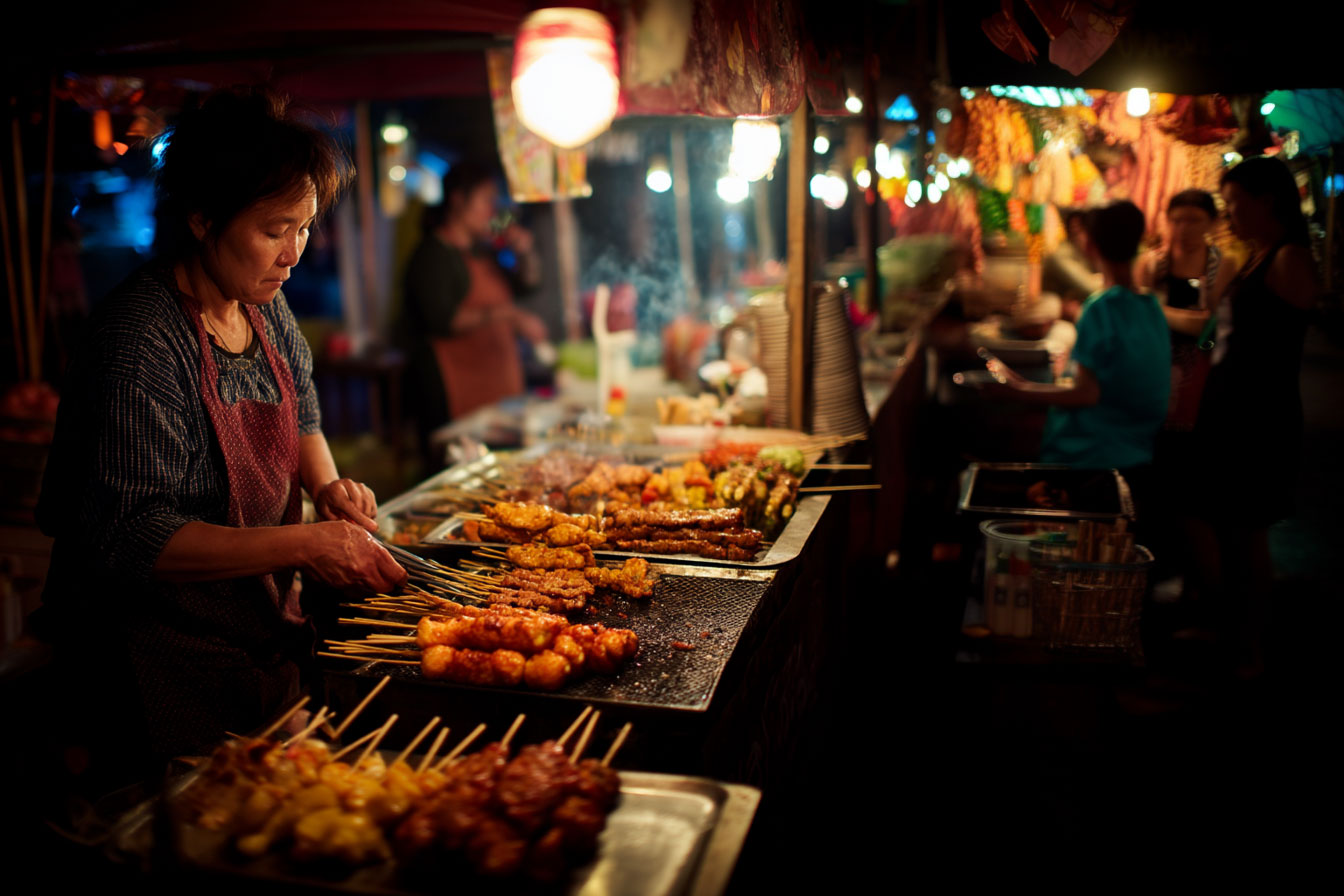Chiang Mai’s Old Town is a square-shaped district surrounded by ancient walls and a moat, where centuries of Lanna heritage blend seamlessly with modern life. Within these streets, food is more than just sustenance.
It is memory, tradition, and identity. Around the Old Town, markets, restaurants, and hidden stalls create a culinary landscape that reflects the history and geography of Northern Thailand.
To eat here is to follow the rhythm of the city, from the bustle of night markets to the calm of wooden houses serving family-style meals.
This article takes you on a journey through some of the most notable food experiences around Chiang Mai’s Old Town, weaving together flavors, cultural meaning, and the city’s evolving identity.
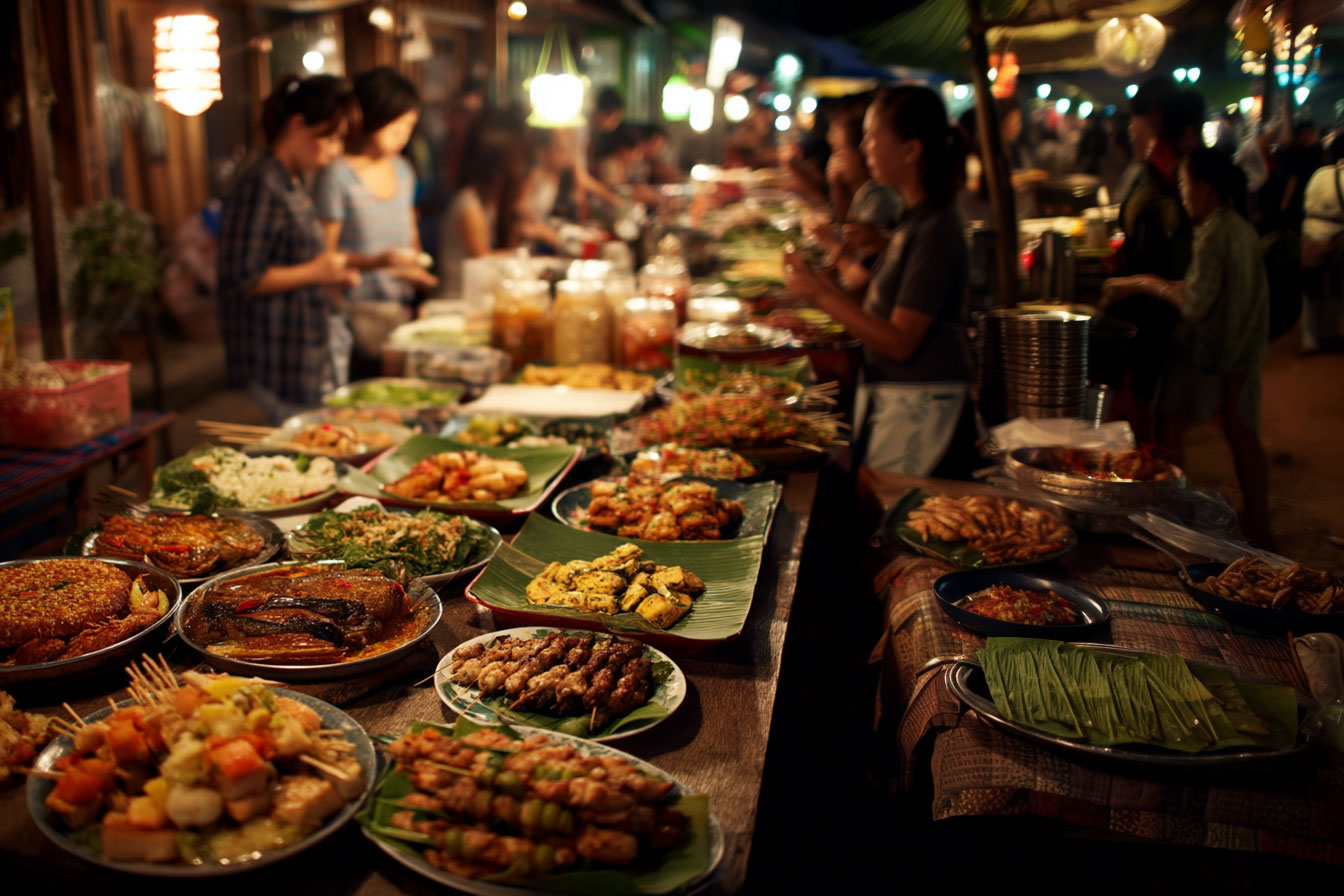
Chiang Mai Gate Night Market: The Evening Feast
At sunset, Chiang Mai Gate Night Market comes alive. Located just outside the southern gate of the Old Town, this market is one of the most popular places in the city for street food. Smoke rises from charcoal grills, oil hisses in large woks, and the clatter of metal ladles echoes from every corner. For locals, this is not a tourist attraction but a practical place for dinner. Its unpretentious atmosphere and affordable prices make it a central hub of daily life.
Among the specialties here is sai ua, the northern Thai sausage. Its flavors are bold, with coarsely ground pork mixed with lemongrass, kaffir lime leaf, galangal, and chili paste. The sausages are grilled until their casings are crisp, creating a smoky aroma that lingers in the air. Sai ua is so distinctly Northern that many visitors buy it as a souvenir to bring back to other regions of Thailand. Served with sticky rice and nam prik noom, a roasted green chili dip, it captures the essence of Lanna cuisine: herb-driven, fiery, and deeply satisfying.
Sticky rice, or khao niao, is the foundation of the northern diet. It is not simply a side dish but a utensil, used to scoop dips and small bites. This simple act ties meals to centuries of agricultural practice, because sticky rice thrives in the cooler climate and highland terrain around Chiang Mai.
For dessert, kanom krok offers another perspective on local flavors. These small coconut pancakes are cooked in cast iron pans, their outer edges crisp while the center remains custard-like. They embody the Thai balance of salty and sweet in a form that is both humble and indulgent. Many visitors end their night here with mango sticky rice, perhaps the most famous dessert of Thailand. While popular nationwide, the mangoes grown in northern orchards, especially during the dry season, are renowned for their rich sweetness and fragrance.
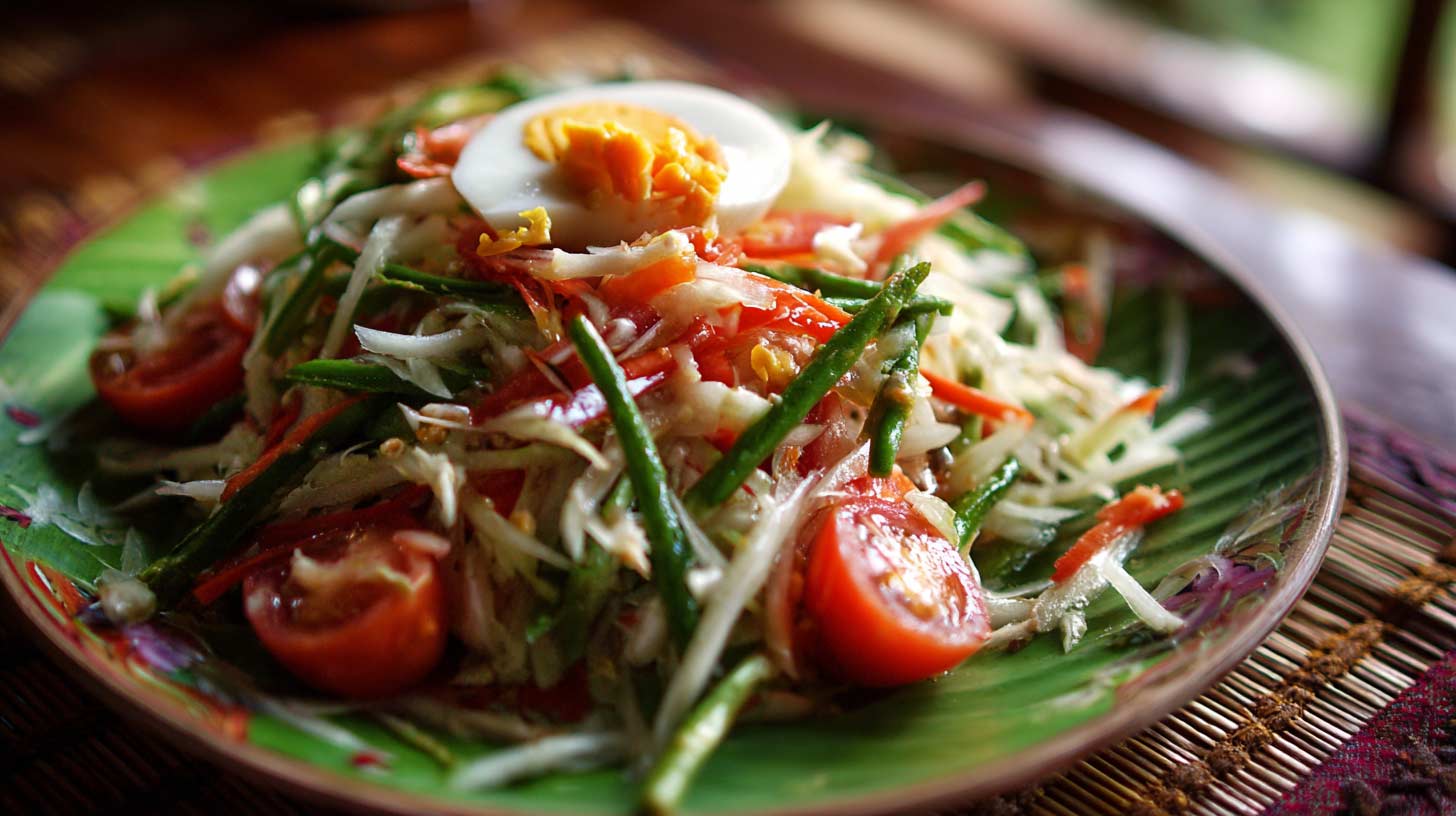
Traditional Lanna Dining: The Khantoke Experience
Crossing into the Old Town through the southern gate, the atmosphere shifts. Within the historic walls, small wooden houses often conceal restaurants that preserve traditions stretching back generations. One of the most iconic ways of dining in Northern Thailand is the khantoke meal.
A khantoke tray is a low, circular stand placed at the center of a table or mat. Around it, multiple small dishes are arranged, always accompanied by sticky rice. The meal is meant to be shared, emphasizing community and hospitality. Sitting around a khantoke is more than eating. It is participating in a cultural practice that has roots in ceremonial gatherings of the Lanna Kingdom.
Dishes on a khantoke tray often include gaeng hang lay, a pork belly curry simmered slowly with ginger, garlic, and tamarind. The dish reflects centuries of cultural exchange, as its origins trace back to Burmese cooking. Unlike curries from central Thailand, it avoids coconut milk and leans toward a tangy-sweet richness.
Another staple is larb muang, a Northern variation of the well-known minced meat salad. While the northeastern version (larb Isaan) is bright with lime juice and fresh herbs, the Lanna version is earthy, made with roasted chili paste, local spices such as star anise and cinnamon, and often eaten with raw vegetables. These spices tell the story of Chiang Mai’s role in regional trade, where flavors traveled along caravan routes from Burma, China, and beyond.
A khantoke is rarely complete without chili dips. Nam prik ong, a tomato-based dip with minced pork, is mild yet savory, while nam prik noom adds roasted green chili heat. Pork crackling and fresh cucumbers often accompany these dips, making them as textural as they are flavorful.
Of course, khao soi holds a special place in this meal. Known today as Chiang Mai’s signature dish, it is a bowl of egg noodles in a mild coconut curry, topped with crispy noodles and served with pickled greens, shallots, and lime. Its history connects to Muslim Chinese traders who passed through the region, blending culinary traditions into what has become a symbol of Chiang Mai’s cosmopolitan past and present.
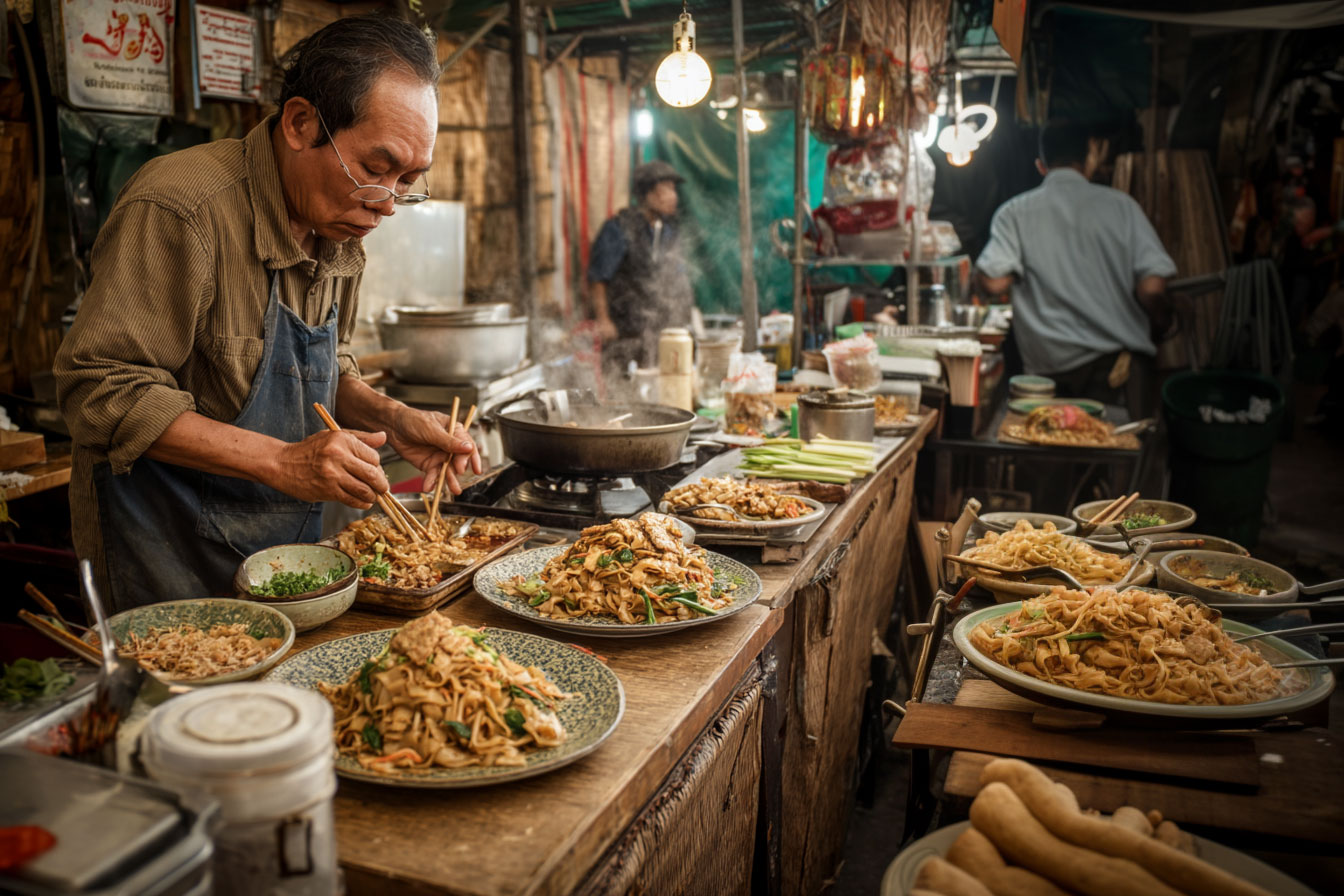
Warorot and Ton Lamyai: Markets by the River
Moving eastward from the Old Town, the banks of the Ping River have long been home to trade. Warorot Market and Ton Lamyai Flower Market stand side by side, reflecting Chiang Mai’s historical role as a commercial hub.
Warorot is one of the city’s oldest markets, and it carries the weight of history. Here, Thai, Chinese, and hill tribe communities have intersected for centuries. The market sells everything from dried chilies and fermented soybean disks to baskets of fresh herbs. In the evening, although the main market slows down, the surrounding streets remain active with food stalls and vendors.
Visitors can snack on grilled pork skewers served with sticky rice, or fried mushrooms sprinkled with chili powder. Coconut ice cream is a local favorite, often served in coconut shells with toppings such as sweet corn, red beans, and roasted peanuts. These combinations may surprise newcomers, but the interplay of textures is part of the Thai philosophy of balance.
Crossing the street leads directly to Ton Lamyai, where rows of fresh flowers create a striking contrast to the food market. Marigold garlands, lotus buds, and jasmine blossoms are sold daily for temple offerings. The sight of people stopping to purchase flowers on their way home reflects how food and spirituality are intertwined in Chiang Mai. The aroma of jasmine mixes with the smoky scent of grilled meats, creating a sensory reminder that here, commerce, devotion, and daily life flow together.
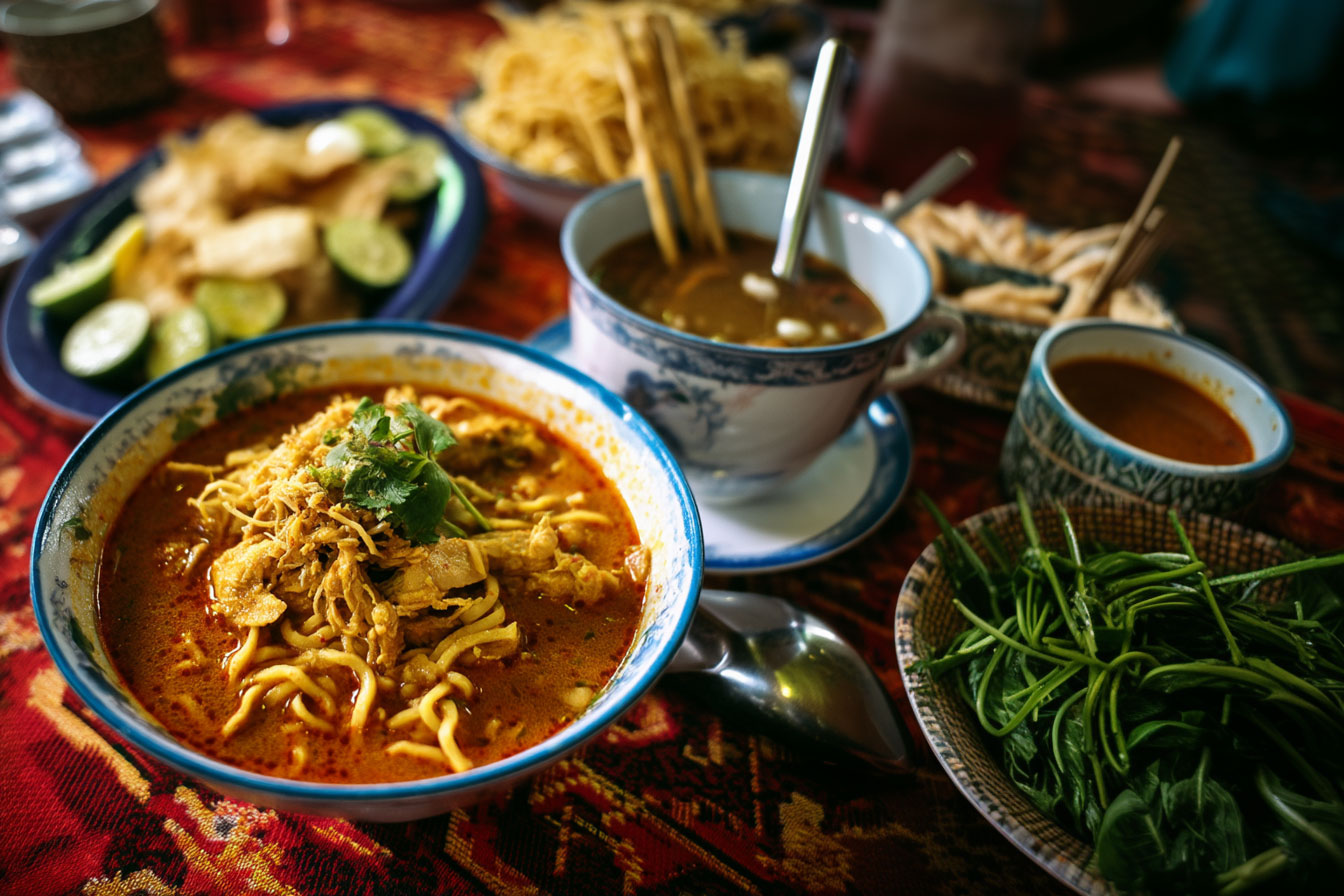
Modern Venues: Where Tradition Meets Creativity
Chiang Mai’s food scene is not only about tradition. The city has a thriving creative community that blends culinary heritage with contemporary expression. Around Tha Phae Gate, one of the busiest entrances to the Old Town, small venues bring together art, food, and performance.
One example is Thapae East, a cultural space known for live music, film screenings, and art exhibitions. Visitors can sit with a drink while listening to mor lam, the folk music of Thailand’s northeastern Isaan region. The rapid rhythms and distinctive sound of the bamboo khaen create an atmosphere that feels spontaneous and energetic. Experiencing music alongside Chiang Mai’s food offerings highlights how culture here is layered and evolving.
This combination of tradition and creativity defines the city’s character. From wooden houses serving preserved recipes to modern spaces that celebrate regional diversity, Chiang Mai offers a full spectrum of culinary encounters.
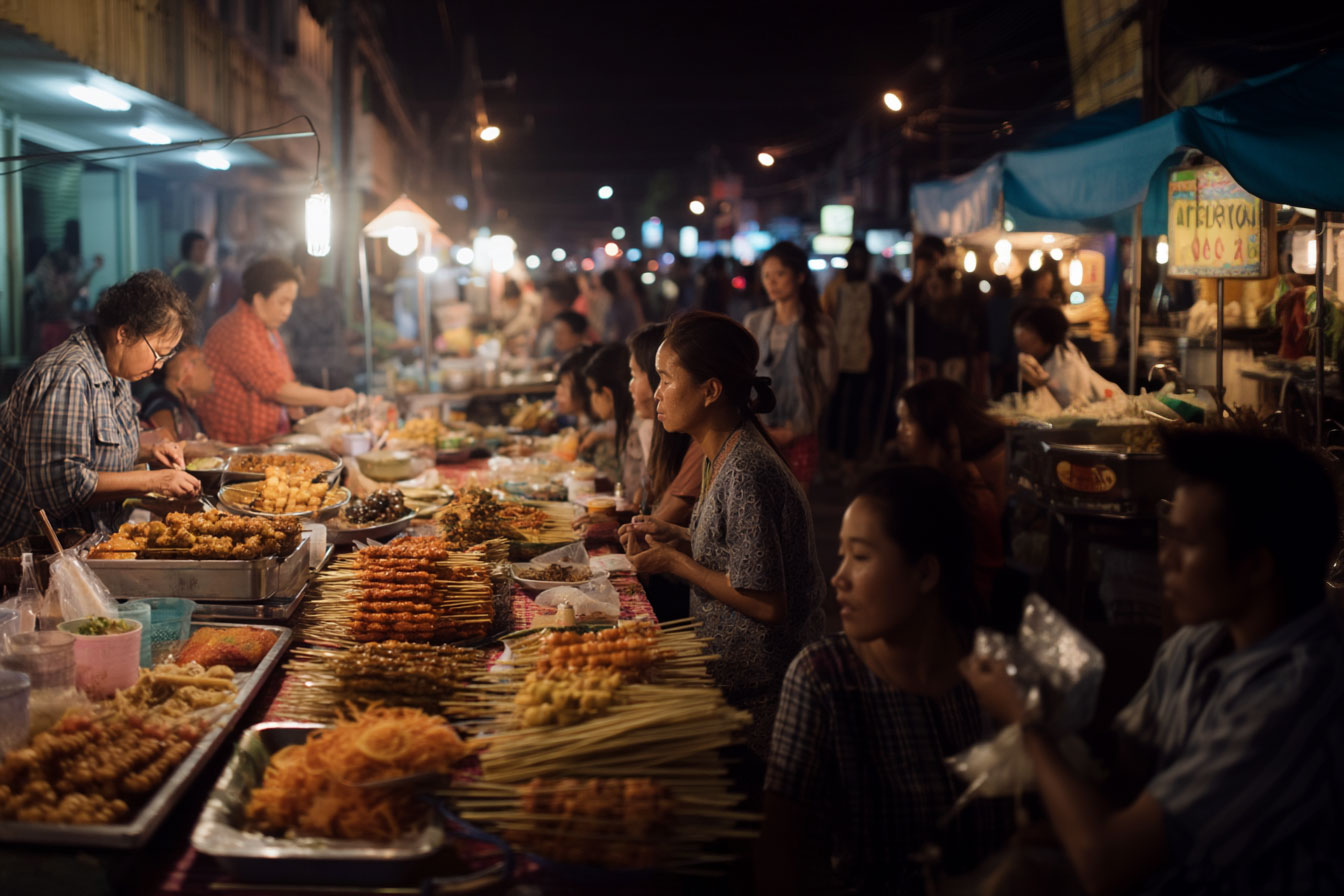
The Cultural Heart of Food in Chiang Mai
What unites these different experiences is the way food connects to place. Chiang Mai’s cuisine is deeply influenced by its geography. Surrounded by mountains and valleys, the region grows herbs and vegetables that thrive in cooler air. Sticky rice fields dominate the landscape, while trade routes historically introduced spices and techniques that continue to shape local dishes.
Food here also reflects values of sharing and community. Whether at a night market stall or around a khantoke tray, meals are structured for interaction, with small plates meant to be sampled and exchanged. This contrasts with Western traditions of individual plates and highlights the importance of food as a social anchor in Northern Thailand.
For visitors, exploring food around the Old Town is more than tasting. It is an introduction to Chiang Mai’s layered identity. Each dish, each market, and each venue tells a part of the story.
Keep exploring
Conclusion: A Journey Through Flavor and Culture
A single evening can take you from smoky grills outside Chiang Mai Gate to the delicate arrangements of the flower market by the Ping River, and finally to a creative venue near Tha Phae Gate. Along the way, food reveals the city’s past, present, and future.
Street food demonstrates the vibrancy of daily life, khantoke dining connects to Lanna heritage, markets show the role of trade and community, and modern venues reflect creativity and openness to new influences. Chiang Mai’s Old Town is not only a historical district but also a living culinary landscape.
In Chiang Mai, food is inseparable from the rhythm of the city. It embodies history, geography, and culture. To eat here is to share in a tradition that values balance, care, and connection. For anyone exploring the Old Town, the flavors of Chiang Mai are as essential as its temples, markets, and ancient walls.
